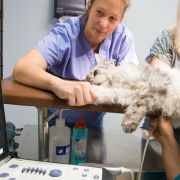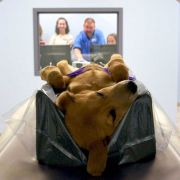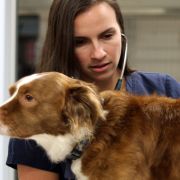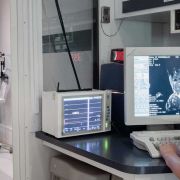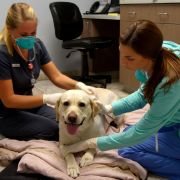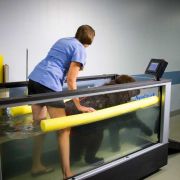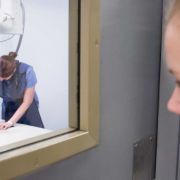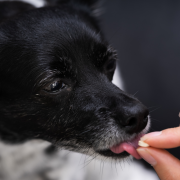Date:
By Alan Green with Heather Graham
For many months we have concentrated on our sporting breeds and a variety of performance, orthopedic and neurological conditions that may affect them, and we intend to continue to do so. This month's guest writer, Dr. Heather Graham, our superb internal medicine specialist, discusses a topic closer to home. Most pet owners at some time will experience the uncomfortable and sometimes worrisome situation of urinary incontinence in your pet. Dr. Graham discusses this very important topic.
Nobody enjoys cleaning up “piddle” but — sometimes accidents happen. If these accidents become a common daily occurrence, then this may be cause for concern, particularly if your pet is being given ample access to appropriate opportunities to relieve themselves. A good potty location for your cat may be a clean litter box in a quiet location away from foot traffic and other general hubbub, and, if you have multiple cats, the rule of thumb equation is number of cats + 1 = number of litter boxes you should have in your home, all in different locations.
If you have a pooch, then frequent walks outside with lots of time to take care of business, and/or access to a doggy door with a secured yard area for safe and leisurely potty breaks are necessary. If these resources are available to your furry friendband the accidents continue — particularly if this is a pet that was previously house-trained — this is cause for concern that there may be a medical problem causing this unseemly new habit. Some observations you can make at home will help your veterinarian narrow down the list of possible culprits enormously.
The devil is in the details when approaching urinary incontinence, and information that you bring with you to your pet’s appointment can be immensely helpful. Make note of your pet’s level of awareness during accidents (i.e. are they posturing to void, are they hiding or going to the other room to void), the most common situations in which accidents occur (are they intermittently or continuously dribbling as they walk around or are they leaking when they are asleep or very relaxed only?), the volume of urine being produced, any discoloration of the urine, the character of the urine stream (continuous stream or spurting, narrow diameter, straining) and any other signs that the problem may be more of a systemic problem (appetite, thirst, activity level, and bowel function). Similarly, if there have been any treatments administered for this problem, let your vet know the medication name, dose, duration of treatment, and whether or not any improvement was noted.
Considering that our pets can’t tell us what’s wrong, you, as the pet owner, are your veterinarian’s eyes and ears, and we put great value in the information you glean from your observations in the home environment. A good history is one of the most important tools we have, but it only gets us so far in our efforts to nail down the diagnosis. Once armed with the invaluable information that you can provide us by answering the above questions, we can better decide what test or combination of tests would be of the greatest use in further narrowing in on the diagnosis.
Essentially, we start with a very long list of possible causes of urinary accidents that fall into numerous broad categories: kidney disease, liver disease, hormonal imbalances or deficiencies, disorders of calcium and electrolyte balance, infections (within the urinary system or in other organ systems), toxin exposure, autoimmune disorders, urinary stones, tumors (within the urinary system or in other organ systems), neurologic or neuromuscular disorders, behavioral conditions — the list goes on and on. Ultimately, unlocking the mystery of urinary accidents becomes a process of elimination.
This process is guided by combining the history and description of clinical signs that owners provide, physical exam findings, and diagnostic testing which may consist of any number of procedures including, but not limited to urinalysis, culture, bloodwork, and various methods of diagnostic imaging (radiographs [x-rays], ultrasound, contrast studies, urethrocystoscopy [“scoping”]). Depending on the results, your friend may benefit from medical, surgical, or behavioral interventions, but your veterinarian will be able to help you determine which combination best suits your little furball’s needs and helps keep your floors free from the dreaded piddle!







